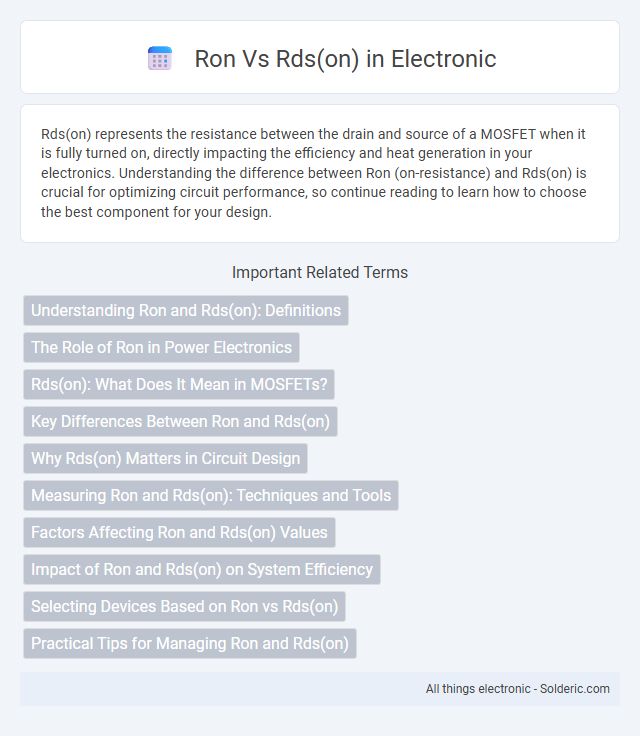Rds(on) represents the resistance between the drain and source of a MOSFET when it is fully turned on, directly impacting the efficiency and heat generation in your electronics. Understanding the difference between Ron (on-resistance) and Rds(on) is crucial for optimizing circuit performance, so continue reading to learn how to choose the best component for your design.
Comparison Table
| Parameter | Ron (On-Resistance) | Rds(on) (Drain-Source On-Resistance) |
|---|---|---|
| Definition | General resistance of a device when fully on | Specific MOSFET resistance between drain and source when on |
| Measurement | Measured as voltage drop divided by drain current | Measured at specified gate voltage and temperature |
| Application | Used for switches and transistors broadly | Used specifically for MOSFET power loss calculations |
| Units | Ohms (O) | Ohms (O) |
| Factors affecting value | Material, device geometry, temperature | Gate voltage, channel length, temperature |
| Importance | Indicates device conduction efficiency | Key for MOSFET efficiency and thermal management |
Understanding Ron and Rds(on): Definitions
Ron, or channel on-resistance, refers to the resistance between the drain and source terminals of a MOSFET when it is fully turned on, directly affecting power loss and efficiency in electronic circuits. Rds(on), a specific type of Ron, denotes the resistance value measured when the MOSFET is in its ohmic region during normal operation, typically specified by manufacturers in datasheets. Understanding these resistances is crucial for optimizing switching performance, minimizing heat dissipation, and ensuring reliability in power management applications.
The Role of Ron in Power Electronics
Ron, or the on-resistance of a MOSFET, critically impacts efficiency and thermal performance in power electronics by influencing conduction losses during operation. Lower Ron values reduce power dissipation, improve energy efficiency, and enable smaller heat sinks and compact circuit designs. Your selection of MOSFETs with optimized Ron is essential for enhancing overall system reliability and minimizing energy waste in high-current applications.
Rds(on): What Does It Mean in MOSFETs?
Rds(on) in MOSFETs refers to the "on-state resistance," which is the resistance between the drain and source terminals when the MOSFET is fully switched on. It directly impacts power loss and efficiency, as lower Rds(on) results in less heat generation and better conductivity. You should consider Rds(on) carefully when selecting MOSFETs for high-current applications to ensure optimal performance and energy savings.
Key Differences Between Ron and Rds(on)
Ron refers to the on-state resistance of a MOSFET measured under low-frequency conditions, while Rds(on) specifically denotes the drain-to-source resistance when the transistor is fully switched on. The primary difference lies in their application context: Ron is a broader term used for overall conduction resistance, whereas Rds(on) is critical for evaluating MOSFET efficiency in high-speed switching circuits. Understanding Rds(on) helps you optimize power loss and thermal performance in your electronic designs.
Why Rds(on) Matters in Circuit Design
Rds(on) represents the resistance between the drain and source terminals when a MOSFET is fully turned on, directly impacting power dissipation and efficiency in circuit design. Lower Rds(on) values reduce conduction losses and heat generation, improving overall device performance and reliability. Understanding and optimizing Rds(on) is crucial for your designs to achieve maximum efficiency and thermal management in high-current applications.
Measuring Ron and Rds(on): Techniques and Tools
Measuring Ron and Rds(on) involves precise techniques such as the four-wire Kelvin method to minimize lead resistance errors and ensure accurate resistance readings in MOSFETs. Specialized tools like high-precision source meters and semiconductor parameter analyzers enable the application of controlled current and voltage, capturing resistance values under specific operating conditions. Your measurement setup must consider temperature, gate voltage, and device bias to obtain reliable and repeatable Ron and Rds(on) data critical for optimizing power loss and efficiency in electronic circuits.
Factors Affecting Ron and Rds(on) Values
Ron and Rds(on) values are primarily influenced by factors such as temperature, gate voltage, and semiconductor material properties. Higher temperatures typically increase resistance, while optimal gate voltage reduces it by fully enhancing the MOSFET channel. Your choice of device with lower Ron or Rds(on) will improve efficiency and reduce power loss in electronic circuits.
Impact of Ron and Rds(on) on System Efficiency
Lower Ron and Rds(on) values in MOSFETs significantly reduce conduction losses, enhancing overall system efficiency by minimizing power dissipation during current flow. These resistances directly influence the thermal management and reliability of power electronics, as decreased resistance leads to less heat generation and improved energy conservation. Optimizing for minimal Ron and Rds(on) is critical in high-frequency switching applications to achieve maximum performance and reduced energy consumption.
Selecting Devices Based on Ron vs Rds(on)
Selecting devices based on Ron vs Rds(on) requires understanding that Ron typically refers to the total on-resistance of a transistor including package and contact resistance, while Rds(on) specifically indicates the MOSFET's channel resistance under specified gate voltage conditions. Choosing a device with lower Rds(on) ensures higher efficiency and reduced power loss, which is crucial for applications demanding high current capacity and thermal performance. Your selection should consider the operating voltage, current load, and thermal management to optimize device performance and reliability.
Practical Tips for Managing Ron and Rds(on)
Managing Ron and Rds(on) effectively involves selecting MOSFETs with low resistance values to reduce power loss and improve efficiency in your circuits. Minimizing thermal stress by using adequate heat sinks or cooling solutions can enhance the reliability and lifespan of components. You should also regularly monitor voltage drops across the MOSFET to ensure optimal performance and prevent overheating.
Ron vs Rds(on) Infographic

 solderic.com
solderic.com